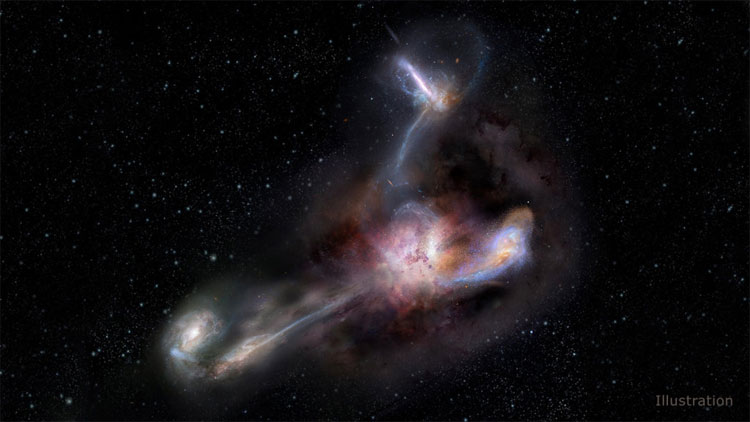The brightest galaxy in the universe
More than 350 trillion times the Sun is absorbing matter from smaller surrounding galaxies as fuel.
WISE J224607.55-052634.9 (referred to as W2246-0526), the brightest galaxy ever discovered, is swallowing at least three smaller galaxies, according to research published in the journal Science on November 15. The amount of material stolen from neighbors may contribute to this bright galaxy.
NASA's WISE space telescope discovered W2246-0526 in 2015. This is not the largest or heaviest galaxy, but it is 350 trillion times brighter than the Sun and 10,000 times the Milky Way.

Galaxy W2246-0526 draws material from neighbors.(Photo: NASA).
New data from the ALMA telescope system in Chile shows cosmic dust tracks pulled out by W2246-0526 from three smaller galaxies. Scientists are not sure if they can escape the current situation or will be swallowed completely by W2246-0526.
Most of the light of W2246-0526 comes not only from stars but also from the amount of hot air and dust gathered around the mind. Between this cloud of dust is a supermassive black hole with an estimated mass of 4 billion times the Sun. Under intense gravity, matter falls into a black hole at high speed, crashing into each other and heating up millions of degrees, so it glows very strongly.
With a huge amount of energy generated, W2246-0526 also needs a lot of fuel, namely dust to create stars and complement the cloud around the central black hole. The new study shows the amount of material that WJ2246-0526 draws from neighbors to compensate for the fuel consumption, thereby maintaining the record brightness of the galaxy.
"It is possible that this meat-eating process has been going on for a while. We expect it will last at least a few hundred million years," said Tanio Diaz-Santos expert at Diego Portales University, the lead author of research, said.

Images from ALMA show W2246-0526 with a smaller galaxy (middle) and two other galaxies at the top and bottom left.(Photo: NASA).
The galactic cannibalism in the universe is not unusual. Previously, astronomers also observed some instances of galaxies merging together or galaxies taking matter from neighbors . W2246-0526 is the farthest galaxy ever found to steal material from many sources. The distance is too big to cause light from W2246-0526 to take 12.4 billion years to reach the Earth.
"Through old data, we know there are three companion galaxies but there is no evidence of the interaction between these neighbors with the central galaxy. We do not think that will be carnivorous behavior, but New research with the ALMA telescope system has clearly confirmed , "Diaz-Santos said.
The greed of W2246-0526 can lead to self-destruction. Scientists hypothesize that such ultra-bright galaxies and absorbing so many surrounding matter will eventually spray gas and dust into the universe. This makes the new stars stop forming, bringing the galaxy into a "retirement" state . Meanwhile, other galaxies continue to renew themselves by producing stars.
- Expose the brightest galaxy ever
- The brightest galaxy in the universe is evaporating
- Discover the oldest galaxy in the universe
- What's interesting about the farthest galaxy in the universe?
- Revealing the largest galaxy in the universe
- One of the youngest and brightest galaxies in the universe
- Find the farthest galaxy
- Candidate of the first galaxy of the universe?
- 6 'quiet' galaxies suddenly become the brightest quasars in the universe
- Discovering the universe 'most lonely' universe
- Where is the most lonely place in the universe?
- Discover the mystery of the most exotic black holes in the universe
 Van Allen's belt and evidence that the Apollo 11 mission to the Moon was myth
Van Allen's belt and evidence that the Apollo 11 mission to the Moon was myth The levels of civilization in the universe (Kardashev scale)
The levels of civilization in the universe (Kardashev scale) Today Mars, the sun and the Earth are aligned
Today Mars, the sun and the Earth are aligned The Amazon owner announced a secret plan to build a space base for thousands of people
The Amazon owner announced a secret plan to build a space base for thousands of people